Give Greener This Holiday Season

The winter holidays are creeping up on us, and along with them come the ghosts of bad gifts past and the environmental cost of all that consumerism.
Holiday gift exchanges are rife with cheap plastic toys and novelty gifts that will be forgotten by the new year. Not to mention all the packaging and wrapping paper that required fossil fuels and trees to produce—only to be thrown right into the trash.
Even when you try to pick the perfect gift, it comes wrapped in raw materials, mined and harvested from wildlife habitats, and pollution from production and packaging. And, despite your best gift-giving efforts, it still may end up going to waste. Three in 5 Americans admit to lying about liking a gift they’ve received, and nearly a third of people who accepted a gift they didn’t like threw it in the trash. Even if your gift is returned to the store, there’s still a good chance it will end up in a landfill.
I’m not here to steal your holiday cheer. Even as an environmental activist, painfully aware of how wildlife pays the price for our wasteful ways, I appreciate the benefits of gift-giving traditions. Giving and receiving gifts can be a powerful way to connect with our loved ones. There’s anticipation, happiness and—when you give or receive the right gift—it can spark joy well beyond the holidays.
Many kids know that making a list is the secret to avoiding the disappointment of well-meaning parents picking out the wrong thing. As environmentally conscious adults, we should use that same strategy to ensure that our well-meaning loved ones don’t buy gifts that will haunt the planet with waste and pollution.
The Center’s SoKind registry makes it easy to ask for exactly what you want with an emphasis on gifts that have a minimal environmental footprint—homemade items, charitable donations, secondhand goods, experiences, and presents of time and skill.
You can even create your own GiveList to showcase the alternative gifts you can offer others, like whipping up a homecooked meal or showing off your carpentry skills.
The climate and extinction crises may make it tempting to simply scrooge your way out of gift exchanges. But if giving and receiving gifts is part of your holiday tradition, here are some ideas to get you started:
Gifts of experience
A 100-mile round-trip drive to visit wildlife in a nature center or refuge creates 10kg CO2 less than buying a plush animal toy—plus it’s not stuffed with polyester. Seeing wildlife can strengthen our connections with the natural world and our desire to protect it. You can also stay local and turn a trip to a nearby park into a wildlife-viewing safari. Want something to unwrap? Find out if your local secondhand store has a bird identification book, or create a colorful themed notebook that can be used as a wildlife observation log.
Gifts of time and skill
While unwrapping gifts may give us a moment to forget about stress, what many of us need is often less tangible: childcare for a night out, pet care for a trip out of town, or assistance with a household project. These gifts are exciting to receive and even more exciting to use. And they don’t cost you or the planet much. They can even come with environmental benefits: If you teach your friend to cook your favorite plant-based dish, you’ll use 14x fewer greenhouse gases than if you’d taken them out for a steak dinner.
Donations to charity
Are you tasked with buying a gift for the person who has everything, or would you prefer to pass on receiving material gifts? Donate—or ask for donations—to a cause that’s close to your heart instead.
Need more inspiration? Take a look at our sample gift registries and wildlife-friendly gift guides.
Holiday gift exchanges aren’t the root cause of all our environmental crises, but they’re a major symptom of the larger consumer culture that helps drive habitat destruction, pollution, and biodiversity loss. By rethinking what gifts can be and how we ask for them, we can bring less stress and more meaning back to the holidays.
This blog post originally appeared on Medium, viewable here.
